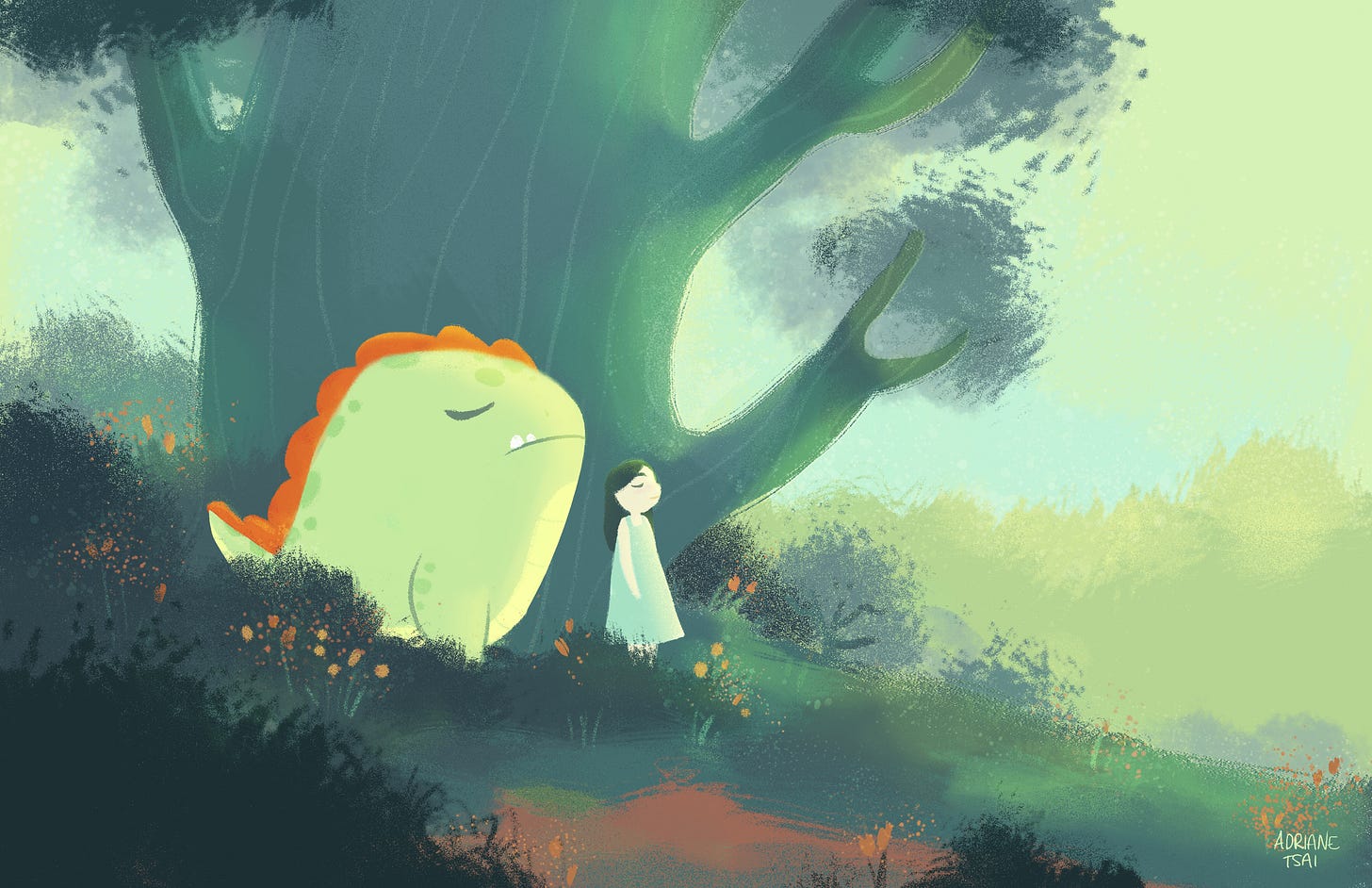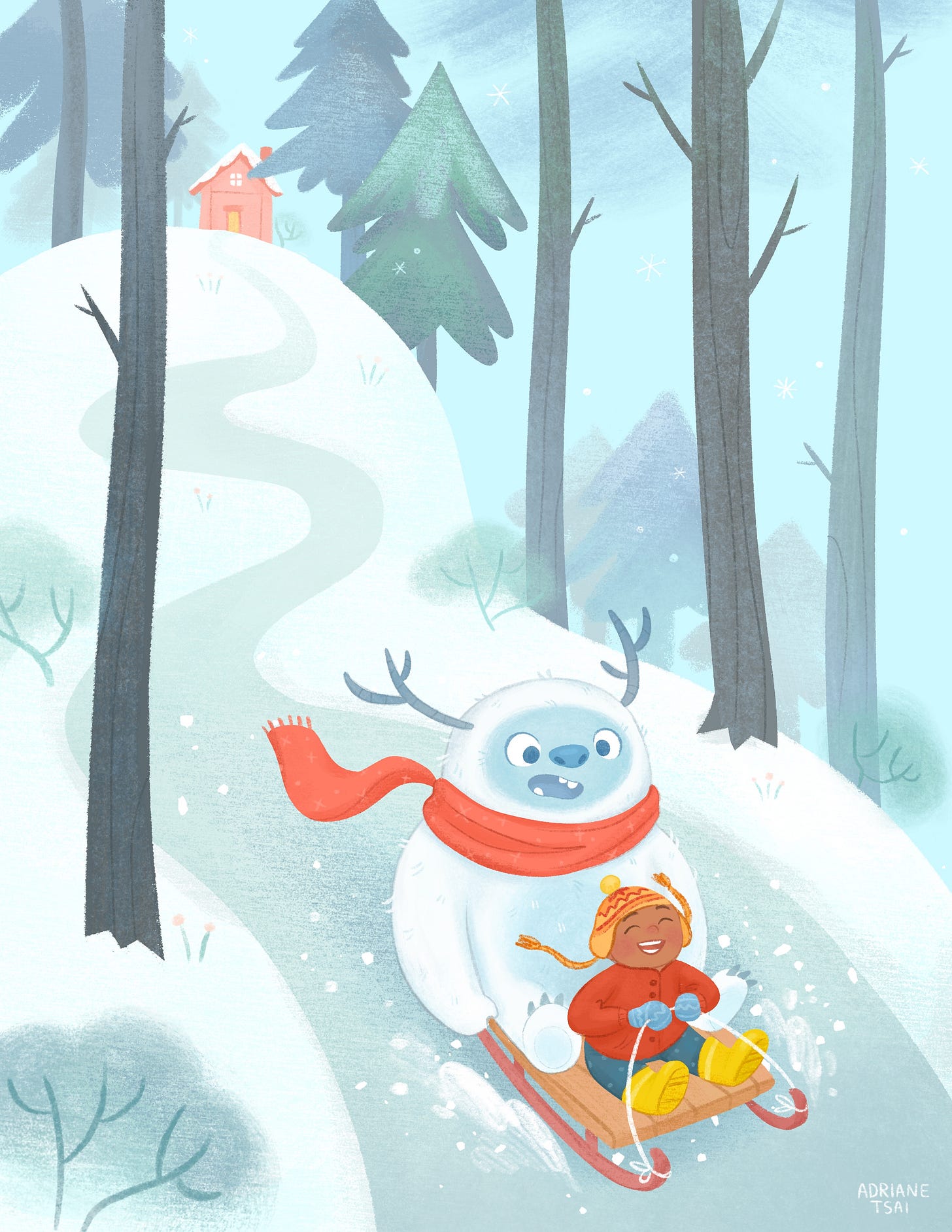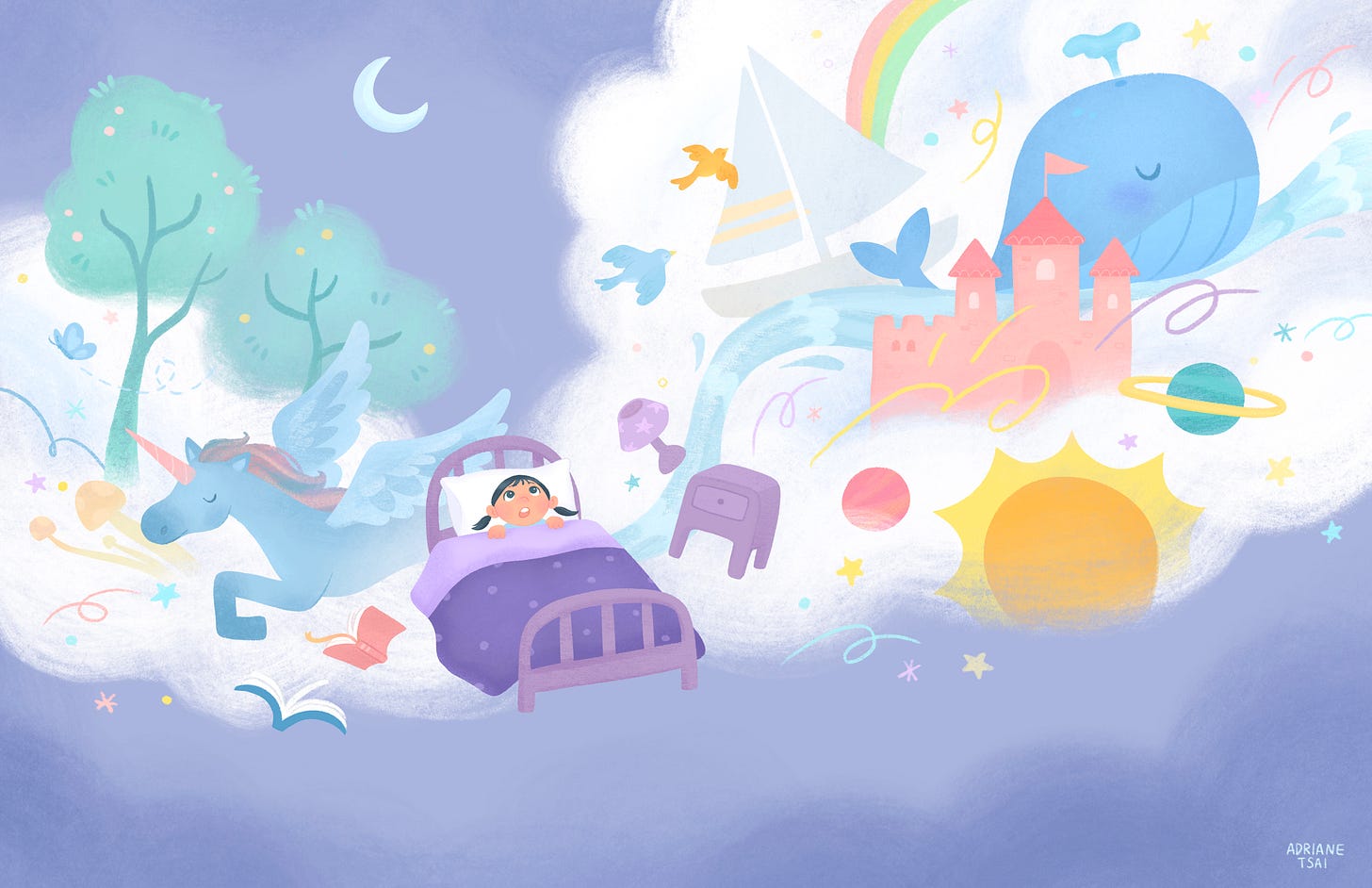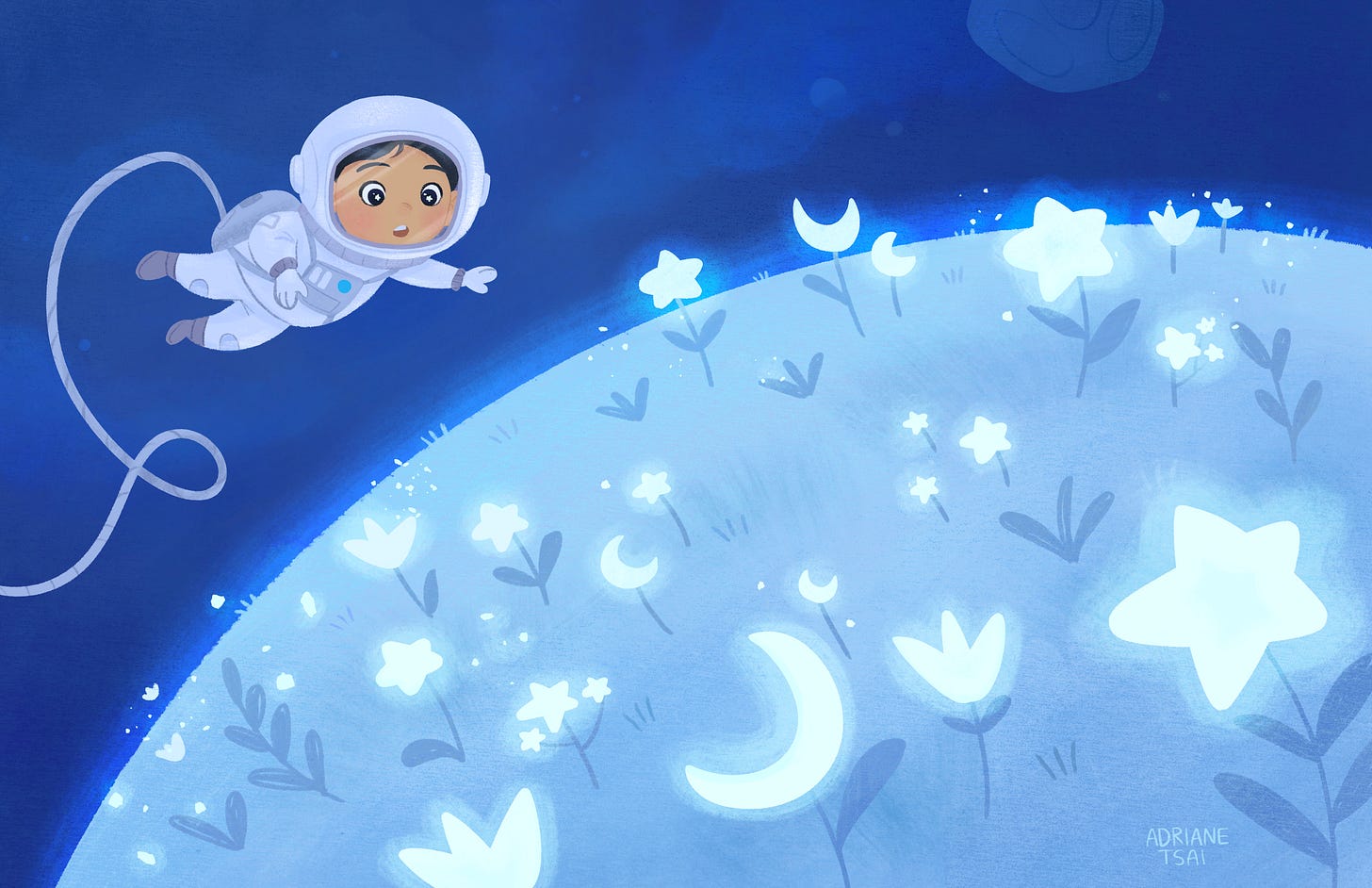ILLUSTRATING CHILDREN’S BOOKS WITH ADRIANE TSAI
Great art is a great story. This week we’re speaking to Adriane Tsai, a children’s book illustrator whose covers combine the shapes of childhood with the stories we grow to cherish. Read our interview with her, and click on the images to visit her portfolio.
What got you started as an artist, and were children's book illustrations always the endgame for you?
I started taking art classes when I was in high school at Fullerton Community College. I was there for about five years, and I graduated with two art certificates. After that, I thought, “I've been doing school for so long already that I want to do my own thing. Maybe I can get freelance work for my resume or something like that.”
I was still posting a lot on social media and, at the time, Twitter was really big. Now, you know, it's kind of going downhill. But my brother told me to start posting on Twitter like I posted on Instagram. He said, “No the art community on Twitter is huge.”
And I was like, “What are those? Don’t they just post words on there?” I didn't even know you could post photos. So I started posting on Twitter and that's when I became part of the publishing community. The publishing community was huge there.
When I posted stuff, a lot of comments said, “I would love to see this in a children's book,” or “This feels very nostalgic to me, or very peaceful and calming to me for some reason.” When I read those comments, I thought “Oh, that's really nice. Yeah, I would love to do children's books.” I think because so many people said it, that's what actually put it in my mind.
And then, a self-published author, Irene Kang (she runs Spark Collection), found me on a Facebook group, Asian Hustle Network. I started working with her, and that was the first time I ever worked on children's books. We worked on a whole series together, and we actually finished our last book this past year. Because that was my first experience In children's books, and it was self-published, I had to figure out how to make the contracts and everything with just us two.
Around the same time, my current agent contacted me on Twitter. There are a lot of hashtags and posts that you can share your work under, like #PortfolioDay or #KidLitArtPostCard which is great because that's totally book-specific. I think I posted on #PortfolioDay, and then my agent reached out to me. At that time, I didn't know anything about publishing, so I thought it was a scam. I don't know who this person is.
And it's awesome because it turns out that the agency is really reputable. My agent is awesome. I was really fortunate that the person who reached out to me when I didn't know what I was doing was really good, or else I wouldn't have signed anything.
That's what led me to children's books, and once I started, I realized that it's literally everything that I love about art. I really like the character design process, but I really like the fact that the final illustration, with every single stroke that you draw, ends up being printed. Every shape, as illustrated, is something that you’ve decided on.
How long have you been with your agent?
I'm pretty sure it was 2020 or 2021, maybe 2021.
Tell me about the collaborative process when it comes to designing a children's book. I don't know if your agent is an intermediary there. How does that work?
It's completely different between traditional published projects and self-published projects. My agent only works on the traditional publisher side. When I was self-publishing, it was just me and the author working directly together. With that, it can vary completely from project to project, depending on who you're working with.
When the book is self-published, it's more like, “Oh, this is my baby.” You want a little bit more control. You're working directly with the author. So [Irene and I] would do real-time work meetings where I would sketch the pages, or would make revisions. I would just share my screen. I still recommend doing that process because instead of having to go back and forth through email due to the long distance, we can be from anywhere.
With the traditional publisher, they give you a lot more freedom because they're running a tight ship. They have so many projects that they're working on at once, they're not micromanaging every little thing. They already have their production pipeline set out, so every person is doing one specific job.
You're usually working with an editor or maybe an art director, so you're not even getting direct feedback from the author. Sometimes they do give feedback, but they don't have as much control.
But there is a middleman, which is the person at the publishing house. And then, down the line, you work hand-in-hand with the designer. Someone else has the text for you and puts everything together in the end. So everyone has a part they play.
For me as an illustrator, my job is to do the illustrations and that's it. I try not to worry about other things. They trust that they're hiring you as a professional to make it happen. The only revisions that I got were very technical, like “Oh, we need to move this, or we need to change this because the text isn't going to show up on it.”
With them, it's more hands-off because right from the beginning, they give you deadlines for the whole project. If it's a year they're giving you, okay, then this month sketches are due. And then we're going to give you feedback two weeks later. And then a month later your rough color will be due. The whole timeline is already mapped out for you. Your time management has to be a little bit better because you have to hit these deadlines.
It's kind of interesting because they say, “Okay, I’ll see you in two months when I'll see your work,” and then they'll give you feedback. It's a mutual trust that the other person will follow. They'll give feedback and I'm going to deliver my art.
Like many artists, you seem all-in. You're telling me about publishing jobs, your portfolio shows you have a shop open, you offer courses. What is your version of success? At what point are you like, “Oh yeah, I've made it as an artist.”
There is a financial aspect that I think, when you're young or when you're a kid and have these artist dreams, that looks a little bit different. I would say success is partially the consistency because you can have one really awesome job, but then that doesn't necessarily make a career.
For me, it's about developing that consistent career that I can rely on and say, “Okay, I can be confident making enough money and surviving off of this.” I’m finding that groove for myself and hopefully becoming established enough that work comes in more consistently.
There's always going to be ups and downs, but right now I'm building up everything slowly, which is really good. Another one of my goals is to start writing and illustrating my own picture books as well. I'm trying to work on those. So yeah, a little bit of the dream aspect, but also a responsible financial aspect as well.
Absolutely. Now a little more into the nitty-gritty of your actual workflow: What tools are you using to illustrate?
I'm mainly illustrating in Procreate. I still have Photoshop, and I really like Photoshop, but Procreate is awesome because I like being able to draw directly on my screen.
But there are some limitations. I use Photoshop here and there for certain effects or for changing file types or, you know, more technical things.
I think you're very skilled at using light in a way that I think a lot of artists aim for with soft light. But I'm looking at it right now and I'm curious about its role. How are you thinking about light when you make something?
I'm so glad that that's what comes across. It's interesting because I actually don't feel like I'm the best at lighting. There are a lot of rules about how light actually works, like scientifically, that artists try to incorporate.
That always would pigeonhole me or I would think about it too much. I would overthink it. Does this lighting actually make sense? And a lot of times it wouldn’t, for whatever I was trying to convey. I think I can get away with it because my work is not super realistic. It's flat in a sense. So what I focus on instead of it being super accurate, I focus on more of the composition and the shapes that the light creates.
I also like to work with very soft, glowy things. I love working with that effect. And, using that effect a lot, I use layer mode. In Procreate or in Photoshop, you can set your glowing layer mode to overlay. That creates a really pretty glowing effect that I like, but I keep it textured rather than a completely soft airbrush because it fits with my style better.
Is there a favorite piece of work that you've done? Like they're going to have a museum exhibit about you, and that's the one at the end of the hall.
Oh man, I don't really think so. I don't know. I feel like my style is constantly changing. There'll be a piece that I really like, and the next year I'm sick of it.
One that I enjoy now is my piece with the little astronaut, my kid. That one I did really fast, but I really like the the feeling of this piece. I like the concept. And it came accidentally, like, I'm pretty sure I was just doing whatever. It's always fun when something like that happens. So that's one that I enjoy right now. But that'll probably change in a year or two.
I think it's refreshing when you look at your old work and think, “Oh, it's going to make me cringe, and I'm going to hate it,” and then you're pleasantly surprised. Like yeah, past me was kind of smart. They kind of knew what they were doing.
Sometimes I feel like I was so much more inspired when I was younger, especially when you're first figuring it out and you have that freedom because you don't have any rules, right? Now when I create a piece, I want to make sure that I can show that I can draw kids, or I need to show something that's missing from my portfolio.
There’s something about when you're younger and fully exploring-- I think that's really special. Sometimes I look back at those and I'm like, okay, this is almost like the truest form of myself. Of course, we evolve and we change, but there's a very raw quality that’s less refined, less technical.
So the last question: What resources did you use when you first started that were either free or super accessible?
Yeah, I think what was huge for me was when I was in high school, a lot of the stuff I did outside of my classes was on YouTube. At that time, there were very few artists there creating videos and they were already amazing. And nowadays we have a plethora of free content out there. Seeing other artists and dissecting it and then trying it with your own work was really, really huge for me.
I was very fortunate that my community college had a great art program. If you're in high school, you can take classes at community colleges for free. I learned a lot there, because at that point I didn't know what jobs there were out there. I didn't know what skills you needed. It was really helpful to learn from teachers and people who have been in the industry or can help break down the pipeline for you.
And then, of course, there are things you can pay for. It is a little bit more investment, but a lot of amazing artists are creating great courses too. Like there's Schoolism, or it could be someone that you admire. Maybe they teach a course on color. Or they teach a course on painting. I feel like stuff like that is invaluable.
Something that I really appreciate is how strong our community is, and supportive we are of each other. That has been very prevalent for me in these past few years. I just really appreciate artists and their values and everything they create. ⬤
Portions of this transcript have been edited for clarity.
Find more of Tsai’s work on her portfolio and Instagram account.
If you’d like The Daily Egg to showcase your work in a newsletter, reach out to us! You can fill out the Artist Highlight form here, or email/DM us for more information.
MAN WAITS FOR ONE DISEASE TO KILL THE OTHERS BEFORE SEEING DOCTOR
(LA MIRADA, CA) In a country where healthcare is increasingly inaccessible, one man believes it's better to fix some things the old-fashioned way. Despite hosting at least fourteen different diseases in his body, including colitis, lupus, and crotch rot, Warren Keiler isn’t going to the doctor. Instead, he’s waiting it out.
“We’re gonna let the germs fight each other, and then we’re going to kill the winner,” his wife Lily explains. She sits next to him in their living room, her body shielded by a poncho-turned-hazmat suit. The reasons behind her precaution stretch across Warren’s face; it’s a petri dish. The fuzz on his chin may or may not be hair, and a bubbling scab cements his lips. “He’s always been a determined man,” she says. “But he believes in a fair fight.”
Lily does most of the communicating but assists Warren with a handful of written responses while we’re together. He slowly types each message on a Chromebook with a finger that looks like it survived a blender. Something twinkles in the man’s sunken eyes after I read his words, but I can’t register whether that glimmer of emotion is pain, pride, or involuntary. When I ask him about it, he takes twenty minutes to answer.
“Can you repeat the question?”
Despite his inability to walk, talk, or smell, Warren insists that loneliness is his greatest affliction. “My friends don’t stop by anymore,” he writes in a later email. “I’ll never forgive them for abandoning me, even after Lily offered to make them suits. We tested this- she’s still alive. The science is sound but the culture needs to catch up.” Days later, Lily tells me that Warren spent six hours typing his email, and his finger fell off after pressing send. ⬤












![[EVENT] L.A. Zine Fest](https://substackcdn.com/image/fetch/$s_!PlGD!,w_1300,h_650,c_fill,f_auto,q_auto:good,fl_progressive:steep,g_auto/https%3A%2F%2Fsubstack-post-media.s3.amazonaws.com%2Fpublic%2Fimages%2F1aa68852-9ac9-4fc2-bf1f-6bc1d775fee2_1500x1000.webp)